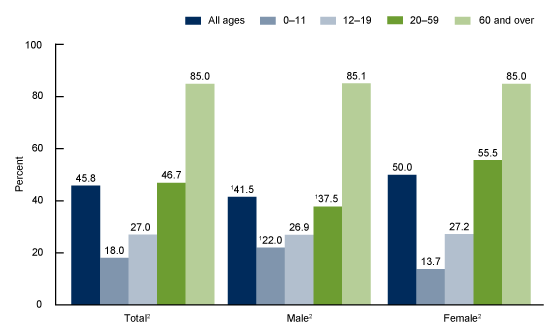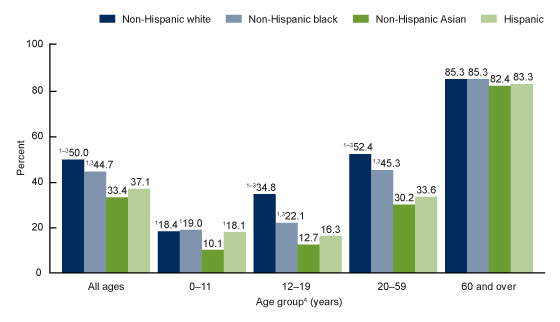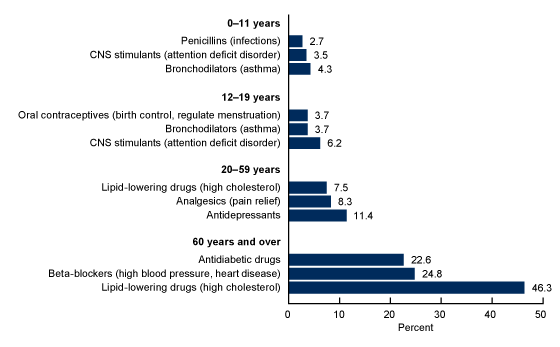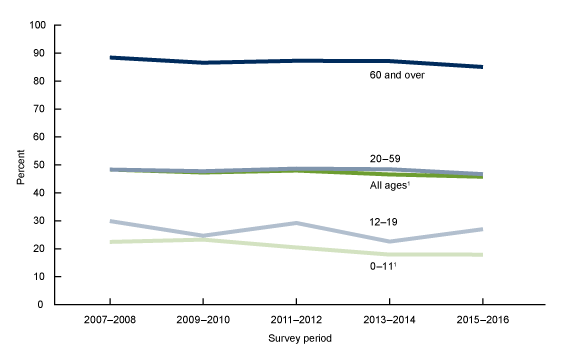Prescription Drug Use in the United States, 2015–2016
- Key findings
- What percentage of the U.S. population used one or more prescription drugs in the past 30 days in 2015–2016, and did use differ by age and sex?
- Did prescription drug use in the past 30 days differ by age and race and Hispanic origin in 2015–2016?
- What were the most commonly used types of prescription drugs in 2015–2016?
- Have trends in prescription drug use changed over the preceding 10 years?
- Summary
- Definitions
- Data source and methods
- About the authors
- References
- Suggested citation
PDF Version (412 KB) | Visual Abstract
Crescent B. Martin, M.P.H., M.A., Craig M. Hales, M.D., M.P.H., Qiuping Gu, M.D., Ph.D., and
Cynthia L. Ogden, Ph.D., M.R.P.
Key findings
Data from the National Health and Nutrition Examination Survey
- In 2015–2016, 45.8% of the U.S. population used prescription drugs in the past 30 days.
- Prescription drug use increased with age, from 18.0% of children under age 12 years to 85.0% of adults aged 60 and over.
- Prescription drug use was highest among non-Hispanic white persons followed by non-Hispanic black persons, and lowest among non-Hispanic Asian and Hispanic persons.
- The most commonly used types of drugs included bronchodilators for ages 0–11 years, central nervous system stimulants for ages 12–19, antidepressants for ages 20–59, and lipid-lowering drugs for ages 60 and over.
- The percentage of the U.S. population that used prescription drugs decreased over the preceding decade.
Monitoring prescription drug use patterns at the population level (1) can inform research and clinical practice. These patterns may shift over time in response to changing health needs, updated clinical guidelines (2) policy changes, and other factors (1,3). The percentage of the U.S. population that used one or more prescription drugs increased from 1999–2000 through 2007–2008 (4). This report describes prescription drug use by age, sex, and race and Hispanic origin in 2015–2016 and trends over the preceding decade.
Keywords: medication, National Health and Nutrition Examination Survey (NHANES)
What percentage of the U.S. population used one or more prescription drugs in the past 30 days in 2015–2016, and did use differ by age and sex?
In 2015–2016, 45.8% of the U.S. population used one or more prescription drugs in the past 30 days (Figure 1). Prescription drug use increased with age, overall and among males and females.
Overall, 18.0% of children aged 0–11 years, 27.0% of adolescents aged 12–19, 46.7% of adults aged 20–59, and 85.0% of adults aged 60 and over used prescription drugs in the past 30 days.
Prescription drug use was lower among males (41.5%) than females (50.0%), although the pattern differed by age. Among children aged 0–11 years, prescription drug use was higher among boys (22.0%) than girls (13.7%), while among adults aged 20–59, prescription drug use was lower among men (37.5%) than women (55.5%). No significant differences by sex were observed among adolescents aged 12–19 or adults aged 60 and over.
Figure 1. Use of one or more prescription drugs in the past 30 days, by age (years) and sex: United States, 2015–2016
1Significantly different from females.
2Significant increasing trend with age.
NOTES: Estimates for all ages are age adjusted by the direct method to the 2000 projected U.S. population using age groups 0–11, 12–19, 20–59, and 60 and over. Crude estimates are 48.1% for total, 43.0% for male, and 53.1% for female. Access data table for Figure 1.
SOURCE: NCHS, National Health and Nutrition Examination Survey, 2015–2016.
Did prescription drug use in the past 30 days differ by age and race and Hispanic origin in 2015–2016?
Overall, prescription drug use was higher among non-Hispanic white (50.0%) persons compared with non-Hispanic black (44.7%), Hispanic (37.1%), and non-Hispanic Asian (33.4%) persons (Figure 2). Prescription drug use was also higher among non-Hispanic black persons compared with non-Hispanic Asian and Hispanic persons. The patterns among adolescents aged 12–19 and adults aged 20–59 were similar to the overall pattern. Among adolescents, 34.8% of non-Hispanic white, 22.1% of non-Hispanic black, 12.7% of non-Hispanic Asian, and 16.3% of Hispanic adolescents used prescription drugs. Among adults aged 20–59, 52.4% of non-Hispanic white, 45.3% of non-Hispanic black, 30.2% of non-Hispanic Asian, and 33.6% of Hispanic adults used prescription drugs.
Among children aged 0–11 years, a lower percentage of non-Hispanic Asian children (10.1%) used prescription drugs compared with non-Hispanic white (18.4%), non-Hispanic black (19.0%), and Hispanic (18.1%) children. Among adults aged 60 and over, there were no differences between race and Hispanic-origin groups in the use of one or more prescription drugs.
For all race and Hispanic-origin groups, use of prescription drugs increased with age.
Figure 2. Use of one or more prescription drugs in the past 30 days, by age and race and Hispanic origin: United States, 2015–2016
1Significantly different from non-Hispanic Asian persons.
2Significantly different from non-Hispanic black persons.
3Significantly different from Hispanic persons.
4Significant increasing trend with age.
NOTES: Estimates for all ages were age adjusted by the direct method to the 2000 projected U.S. population using age groups 0–11, 12–19, 20–59, and 60 and over. Access data table for Figure 2.
SOURCE: NCHS, National Health and Nutrition Examination Survey, 2015–2016.
What were the most commonly used types of prescription drugs in 2015–2016?
The top three types of prescription drugs used by the U.S. population during 2015–2016 varied by age (Figure 3). The most commonly used prescription drug types in the past 30 days were bronchodilators for children aged 0–11 years (used by 4.3% of children), central nervous system stimulants for adolescents aged 12–19 (6.2%), antidepressants for adults aged 20–59 (11.4%), and lipid-lowering drugs for adults aged 60 and over (46.3%).
Figure 3. Use of the most commonly used prescription drug types in the past 30 days, by age group: United States, 2015–2016
NOTES: The primary indication for use of the drug type is in parentheses. Other drug types may also be used for the same indications as those shown. CNS is central nervous system. Oral contraceptives were used by 7.5% of girls aged 12–19. Access data table for Figure 3.
SOURCE: NCHS, National Health and Nutrition Examination Survey, 2015–2016.
Have trends in prescription drug use changed over the preceding 10 years?
Prescription drug use decreased among the U.S. population from 48.3% in 2007–2008 to 45.8% in 2015–2016 (Figure 4). Prescription drug use also decreased among children aged 0–11 years, from 22.4% in 2007–2008 to 18.0% in 2015–2016. The observed declines in prescription drug use among adults aged 20–59 and adults aged 60 and over were not statistically significant, and there was no significant trend among adolescents aged 12–19.
Figure 4. Trends in use of one or more prescription drugs in the past 30 days, by age (years): United States, 2007–2016
1Significant decreasing linear trend from 2007–2008 through 2015–2016.
NOTES: Estimates for all ages are age adjusted by the direct method to the 2000 projected U.S. population using age groups 0–11, 12–19, 20–59, and 60 and over. Access data table for Figure 4.
SOURCE: National Health and Nutrition Examination Surveys, 2007–2016.
Summary
During 2015–2016, almost one-half of the U.S. population used one or more prescription drugs in the past 30 days (45.8%). Prescription drug use increased with age, and a higher percentage of females (50.0%) than males (41.5%) used prescription drugs, but the pattern varied by age. Prescription drug use was higher in males among children aged 0–11 years but higher in females among adults aged 20–59, while there were no differences by sex among adolescents aged 12–19 or adults aged 60 and over. Patterns across race and Hispanic-origin groups also varied by age. Among adults aged 60 and over, no significant differences were observed among race and Hispanic-origin groups.
The most commonly used types of prescription drugs included bronchodilators for children aged 0–11 years, central nervous system stimulants for adolescents aged 12–19, antidepressants for adults aged 20–59, and lipid-lowering drugs for adults aged 60 and over. From 2007–2008 through 2015–2016, prescription drug use decreased for the overall population and for children aged 0–11 years.
Monitoring the use of prescription drugs may describe aspects of the health of the U.S. population. Differences in the most commonly used prescription drug types by age group illustrate differences in the prevalence of health conditions at various stages of life. Changing trends in prescription drug use over time may be influenced by changing disease prevalence and diagnosis (5,6), expanded treatment recommendations (2,7), and decline in the use of inappropriate or ineffective therapies (8,9).
Definitions
Prescription drug use: Participants were asked if they had taken a prescription drug (not including prescription dietary supplements) in the past 30 days. For participants under age 16, a parent or other proxy provided the information. Those who answered “yes” were asked to show the interviewer the medication containers of all prescription drugs. For each drug reported, the interviewer recorded the product’s complete name from the container, if available.
Therapeutic drug class (type of drugs): Prescription drugs were classified based on the three-level nested therapeutic classification scheme in Lexicon Plus, a proprietary drug database of Cerner Multum, Inc. (10). Up to four classes were assigned to each drug. The most commonly cited second level of drug categorical codes were used in this analysis. A drug’s therapeutic class does not always align one-to-one with its primary indication. For example, drugs that are used to treat high blood pressure span multiple therapeutic classes (i.e., ACE inhibitors, beta-blockers, diuretics, and calcium channel blockers), and drugs in a single therapeutic class may be used to treat multiple health conditions (e.g., beta-blockers also can be used to treat certain heart diseases). Different approaches to classifying prescription drugs may result in differences in the most commonly used drug types for a given age group.
Data source and methods
Data for this report are from the National Health and Nutrition Examination Survey (NHANES), a cross-sectional survey conducted by the National Center for Health Statistics and designed to monitor the health and nutritional status of the civilian noninstitutionalized U.S. population. It consists of home interviews followed by standardized physical examinations in mobile examination centers.
The NHANES sample is selected through a complex, multistage probability design. For survey period 2015–2016, non-Hispanic black, non-Hispanic Asian, and Hispanic persons were oversampled; for more information, visit the NHANES website (11). Non-Hispanic race categories reflect persons reporting only one race; non-Hispanic persons reporting more than one race are included in the total but are not reported separately.
Interview weights were used to account for the differential probabilities of selection, nonresponse, and noncoverage. Taylor series linearization was used to compute variance estimates. Estimates for the population of all ages were age adjusted using the direct method to the projected 2000 U.S. census population using age groups 0–11, 12–19, 20–59, and 60 and over. Pairwise differences between groups were tested using a univariate t statistic. Tests for linear trends by age and over time were evaluated using orthogonal polynomials. The significance level for statistical testing was set at p < 0.05. All differences reported are statistically significant unless otherwise indicated. Data management and statistical analyses were conducted using SAS System for Windows version 9.4 (SAS Institute, Inc., Cary, N.C.), SUDAAN version 11.0 (RTI International, Research Triangle Park, N.C.), and R version 3.5.2 (R Foundation for Statistical Computing).
About the authors
Crescent B. Martin, Craig M. Hales, Qiuping Gu, and Cynthia L. Ogden are with the National Center for Health Statistics, Division of Health and Nutrition Examination Surveys.
References
- Kantor ED, Rehm CD, Haas JS, Chan AT, Giovannucci EL. Trends in prescription drug use among adults in the United States from 1999–2012. JAMA 314(17):1818–31. 2015.
- Stone NJ, Robinson JG, Lichtenstein AH, Bairey Merz CN, Blum CB, Eckel RH, et al. 2013 ACC/AHA guideline on the treatment of blood cholesterol to reduce atherosclerotic cardiovascular risk in adults: A report of the American College of Cardiology/American Heart Association Task Force on Practice Guidelines. J Am Coll Cardiol 63(25 Pt B):2889–934. 2014.
- Hales CM, Kit BK, Gu Q, Ogden CL. Trends in prescription medication use among children and adolescents—United States, 1999–2014. JAMA 319(19):2009–20. 2018.
- Gu Q, Dillon CF, Burt VL. Prescription drug use continues to increase: U.S. prescription drug data for 2007–2008. NCHS Data Brief, no 42. Hyattsville, MD: National Center for Health Statistics. 2010.
- Akinbami LJ, Simon AE, Rossen LM. Changing trends in asthma prevalence among children. Pediatrics 137(1). 2016.
- Xu G, Strathearn L, Liu B, Yang B, Bao W. Twenty-year trends in diagnosed attention-deficit/hyperactivity disorder among US children and adolescents, 1997–2016. JAMA Netw Open 1(4):e181471. 2018.
- Muntner P, Carey RM, Gidding S, Jones DW, Taler SJ, Wright JT, Whelton PK. Potential U.S. population impact of the 2017 ACC/AHA High Blood Pressure Guideline. J Am Coll Cardiol 71(2):109–18. 2018.
- Centers for Disease Control and Prevention. Antibiotic prescribing and use.
- Frenk SM, Kit BK, Lukacs SL, Hicks LA, Gu Q. Trends in the use of prescription antibiotics: NHANES 1999–2012. J Antimicrob Chemother 71(1):251–6. 2016.
- National Center for Health Statistics. National Health and Nutrition Examination Survey 1988–2016 data documentation, codebook, and frequencies: Prescription medications–drug information (RXQ_DRUG). 2019.
- National Center for Health Statistics. NHANES questionnaires, datasets, and related documentation. 2019.
Suggested citation
Martin CB, Hales CM, Gu Q, Ogden CL. Prescription drug use in the United States, 2015–2016. NCHS Data Brief, no 334. Hyattsville, MD: National Center for Health Statistics. 2019.
Copyright information
All material appearing in this report is in the public domain and may be reproduced or copied without permission; citation as to source, however, is appreciated.
National Center for Health Statistics
Jennifer H. Madans, Ph.D., Acting Director
Amy M. Branum, Ph.D., Acting Associate Director for Science
Division of Health and Nutrition Examination Surveys
Kathryn S. Porter, M.D., M.S., Director
Ryne Paulose-Ram, M.A., Ph.D., Associate Director for Science



